Universal, high-yielding, early ripening tomato "Siberian miracle" so beloved by summer residents
The Siberian miracle tomato with its impressive characteristics will leave many cultures far behind. The variety is not only well adapted to various weather conditions, even the most severe, but also has a high yield, disease resistance and ease of care.
This is the type of tomato that satisfies all gardeners' needs. Despite the exactingness of modern gardeners, the Siberian culture remains the leader among non-hybrid varieties and collects only positive reviews.
The content of the article
Characteristics and description of the variety
The Siberian miracle was developed by Altai scientists. In 2006, he was entered into the State Register.
Bush indeterminate, standard, 1.3-1.5 m high (slightly higher in the greenhouse). The stem is powerful, the foliage is large, emerald green. The inflorescences are simple.
Reference. The indeterminate bush does not stop growing.
The variety is mid-season - 90-110 days pass from the moment the first shoots appear to full maturity. Fruiting is extended.
The yield is high - from 1 sq. m are harvested up to 13 kg, from 1 bush - 4-5 kg of fruit.
Because of the height, a garter is required. Not only the stem is tied up, but also the branches, despite their strength.
Culture needs pinning. It is formed into 2 stems, regularly trimmed.
The Siberian miracle is characterized by increased resistance to diseases of the tomato series. Well adapted to changes in weather conditions, it does not stop in growth or development.
Fruits are medium, weighing 150-200 g, oval, bright red with a raspberry hue. The skin is smooth. The pulp is dense, moderately juicy. The taste is sweet, with a slight sourness. Seed chambers 5-7. The fruits are not subject to cracking.
Tomatoes are versatile in use. Suitable for pickles, pickles, marinades. They do not lose their taste when canning and making tomato products. Indispensable in summer salads and hot dishes.
The fruits are adapted to long-term storage and are well tolerated for transportation over short distances without losing their appearance and taste. For long-distance transportation, vegetables are picked slightly unripe.
The photo shows the Siberian miracle tomatoes.
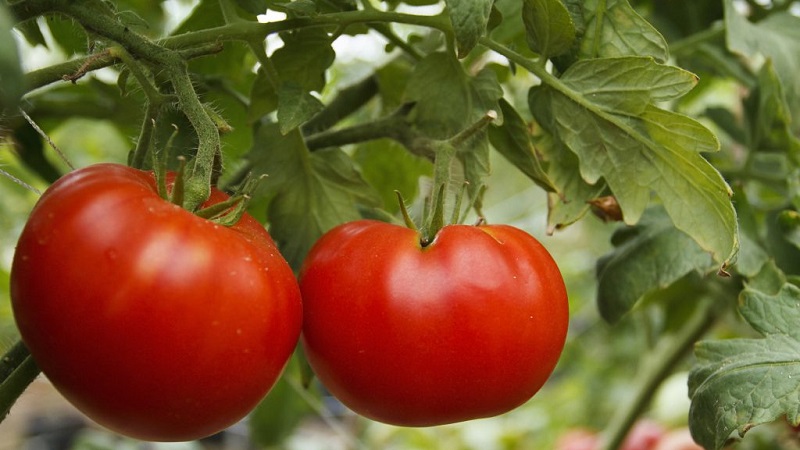
How to grow seedlings
Sowing seeds begins 60 days before planting seedlings in the ground.
The soil mixture is prepared from black soil, river sand, humus, peat and ash. All components are taken in equal proportions. Holes are made at the bottom of the planting containers and the prepared mixture is poured in half.
Seeds disinfect in a weak solution before planting potassium permanganateand then washed with water. The dried grains are placed in the soil to a depth of 2 cm.
A common box, and disposable peat pots or plastic cups are suitable for planting. When planting in an individual container, the sprouts do not need to be dived afterwards.
The convenience of peat pots also lies in the fact that it is not necessary to transplant seedlings from them. Peat pots dissolve in the soil by themselves without harming the root system. The only drawback is that this method of sowing seeds is more expensive than any other.
After sowing, the containers are left in a warm and dark place with an air temperature of 22-24 ° C.
When the first sprouts appear, the seedlings are rearranged on a sunny windowsill, but not in direct sunlight. The soil is slightly moistened. Further watering is moderate, it is not necessary to overmoisten the soil, but the soil should not be allowed to dry out either.After watering, the soil is loosened so that the young roots develop better.
As the seedlings grow, the remaining soil is poured into containers, half filled with soil. This method provides the sprouts with new minerals and trace elements.
If the seedlings were planted in a common box, when two real leaves appear, they must be dived, planting them in separate containers. How to do it correctly, see the video.
2 weeks before planting in the ground, the seedlings begin to harden, taking them out into the open air for 2-3 hours. Gradually, this time is increased to 12-14 hours. In the southern regions, this method is called not hardening, but the adaptation of sprouts to outdoor conditions.
How to grow tomatoes
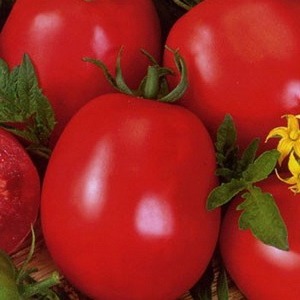 After 2 months, the sprouts are ready for transplantation to a permanent place.
After 2 months, the sprouts are ready for transplantation to a permanent place.
Beds for tomatoes are chosen in a sunny place, protected from drafts.
Planting pattern: 40 cm - distance between seedlings, 50 cm - between rows. For 1 sq. m there are 4 bushes.
The transplanted bushes are tied immediately to the established long supports. It is important that all plants receive the required amount of light, so the installed supports should not shade them.
After transplanting, the holes are watered with warm, settled water, the earth is loosened and hilled. Loosening and hilling promote the penetration of oxygen to the roots, which is necessary for full growth and development.
They switch to regular watering as the seedlings grow stronger. Watered 2 times a week, only at the root and only with settled cold water. In hot weather, the amount of watering is increased to 3-4 per week. After watering, the soil is loosened and weeds and roots are removed.
Mulching with straw retains moisture in the beds, due to which the soil does not dry out for a long time.
At the stage of ovary formation, the bushes require feeding with a high content of phosphorus and potassium. This feeding is carried out 2 times. Throughout the growing season, tomatoes are fed 1 time per 10 days with complex mineral fertilizers or organic matter. As organic matter, infusion of mullein, infusion of weeds and bird droppings are suitable.
Important! The solution should not be very concentrated, otherwise the root system will burn. A 1:15 dilution will not harm the roots.
Bushes need pinching. They are pruned regularly to form a 2-stem plant. With this technique, the highest fruiting rate is observed.
The initial garter of the bushes is carried out immediately during transplantation. Then, as it grows and develops, the grown branches are tied up. Otherwise, the brushes will not withstand the weight of ripe fruits and will begin to creep along the ground, which will lead to rotting of vegetables.
Diseases and pests
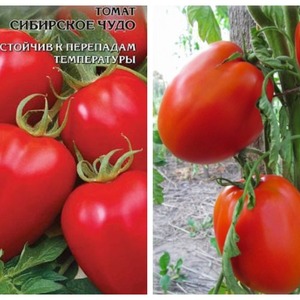 For the Siberian miracle tomato, the main diseases of the nightshade family are not dangerous. However, the crop can be attacked by brown rot and dry spotting.
For the Siberian miracle tomato, the main diseases of the nightshade family are not dangerous. However, the crop can be attacked by brown rot and dry spotting.
Brown rot (another name is phomosis) is a fungal disease. It develops at an elevated level of humidity, so it is important not to allow waterlogging of the beds. In case of a fungal infection, diseased ovaries must be destroyed and the bushes must be sprayed with the preparation "Hom".
Dry spotting also refers to fungal diseases. It is often confused with late blight due to the similarity of symptoms. The leaves are covered with spots of various sizes, then the spots pass to the stem and fruits. The only difference from phytophthora is that the onset of the disease occurs at an early date that is not characteristic of late blight. Favorable factors for its development are a temperature of 25 ° C and high humidity (however, as for any other disease spreading by spores). In the fight against it, fungicides of systemic action are effective, for example, "Quadris" and "Acrobat MC".
Pests should be wary of whitefly and rusty mites. Sharp-smelling plants planted next to the tomato will help get rid of the butterfly.
As for the tick, it is a serious pest of any crop.The sucking parasite is spread by the wind, it is so small that it is not easy to notice it. The plant suffers greatly from its invasion, stops growing, the leaves turn brown and wither, the stem becomes gray and cracked.
Of the folk methods of struggle, the use of infusion of garlic, horseradish, onion husks and wormwood is effective. If the tick has seriously occupied the beds, the drug "Zubr" will help drive it out. But do not forget that the use of insecticides in pest control is permissible only until the fruit is set.
The nuances of growing in open ground and in a greenhouse
The variety is distinguished by good adaptation both in the open field and in greenhouse conditions. The height of the bush in the greenhouse exceeds the growth of the seedling on the street and reaches 1.7 m. In this case, to limit growth, pinch the top of the head.
In the greenhouse, the quantitative yield indicator is slightly higher: from 1 sq. m are harvested up to 15 kg, and from 1 bush - up to 6 kg of vegetables. A culture planted in open beds gives a more modest result.
Growing in a greenhouse implies a less dense planting than outdoors. For 1 sq. m place 3 bushes.
When transplanting seedlings into open ground in cold regions, it will not hurt to stock up on some covering material. It will come in handy in the event of an unexpected cold snap or heavy rains.
Greenhouses need regular ventilation. This will help keep the plants healthy.
Harvesting and application of the crop
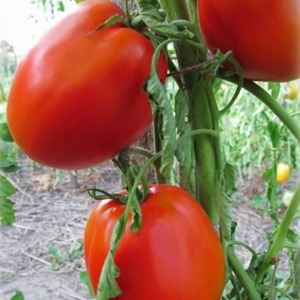 Fruits are harvested in mid-August and lasts until early September. Unripe vegetables are able to pick up color on their own, not inferior in taste to those that are ripe in the beds.
Fruits are harvested in mid-August and lasts until early September. Unripe vegetables are able to pick up color on their own, not inferior in taste to those that are ripe in the beds.
Ripening occurs in waves, which allows you to process the crop without loss. The very first vegetables are usually larger. They are best used fresh.
The use of vegetables in cooking is universal. They are suitable both for preparing fresh salads, hot vegetable dishes, and for preservation. Small size allows you to stack tomatoes whole in jars. They perfectly retain their amazing taste in tomato juices and pastes; well suited for cooking lecho, adjika, ketchup. Moreover, heat treatment of tomatoes only improves their taste. Ripe vegetables are also frozen and dried.
Tomatoes are subject to long-term storage and can withstand transportation over short distances while preserving their appearance and taste. Vegetables intended for long-distance transport are advised to be picked unripe. The variety is suitable for commercial cultivation.
Advantages and disadvantages
The main advantage of Siberian varieties is the ability to take root in any climatic conditions and give rich harvests. This feature is especially important in those regions where heat-loving crops grow poorly and bear little fruit.
Here are some more positive characteristics:
- high germination rate;
- disease resistance;
- the formation of ovaries regardless of weather changes;
- unpretentious care;
- great fruit taste;
- not subject to cracking;
- undulating ripening;
- versatility in application;
- long-term storage;
- possibility of transportation;
- commercial cultivation;
- self-selection of seeds for the next planting.
The negative sides include:
- negative impact of waterlogged soil;
- garter required;
- regular pinching is required.
Farmers reviews
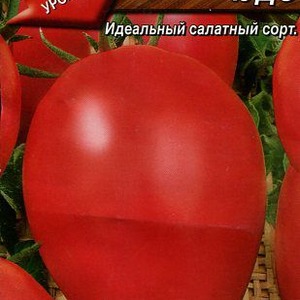 A review of this section will acquaint you with the opinions of both experienced professionals and amateur summer residents. Nobody doubts the versatility of the variety. Those who have planted Siberian culture at least once on their land do not want to part with it and prepare seeds in advance for the next year.
A review of this section will acquaint you with the opinions of both experienced professionals and amateur summer residents. Nobody doubts the versatility of the variety. Those who have planted Siberian culture at least once on their land do not want to part with it and prepare seeds in advance for the next year.
Ekaterina, Kemerovo region: “Our climate is harsh, summer is short. Many varieties do not mature in time. My favorite tomato is a real miracle of Siberia, I have been planting it for 2 years. I never regretted it. Both in winter and summer with vegetables.The variety grows well and does not get sick. "
Galina, Perm region:“I planted it for the first time 5 years ago. The bushes are tall and strong. I tie up, I feed three times a season. Stepson every week. I like the taste. I use it for salads and winter preparations. My favorite tomatoes. "
Conclusion
The varieties of Siberia never cease to amaze with their high adaptation to any climatic conditions. A cold-resistant tomato not only fully develops in the harshest regions of our country, but also gives a rich harvest, collects good reviews in its piggy bank, looks beautiful on the photo and on the table. And at the same time, it is so easy to clean that even any beginner will be satisfied with the result. Therefore, we can safely say that the name of the variety is not exaggerated.